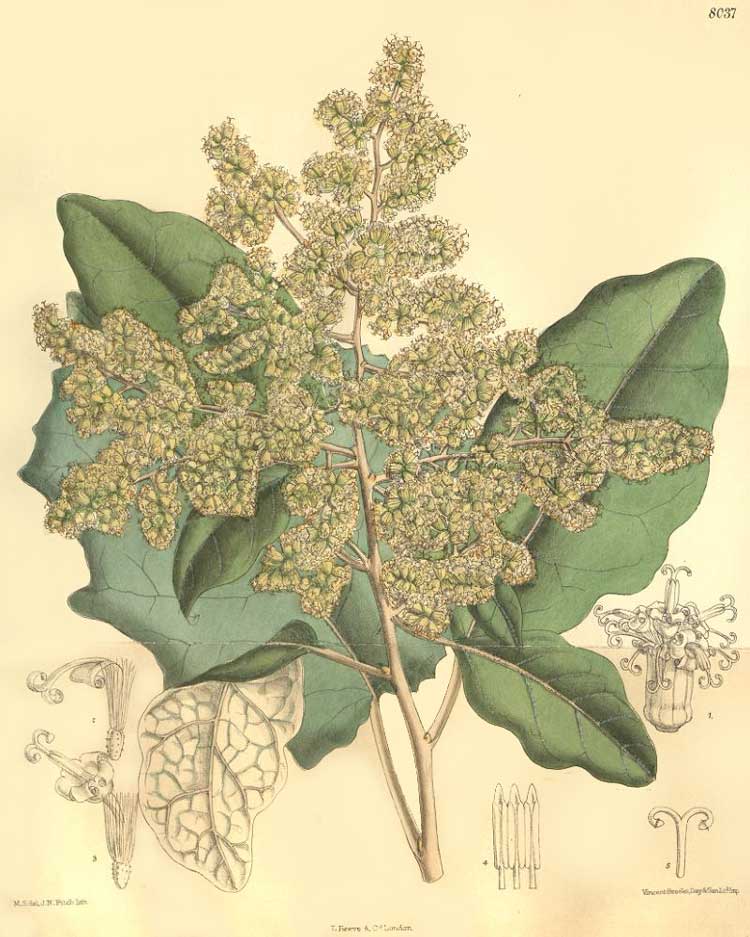
Brachyglottis repanda
Classification System: APG IV
Superregnum: Eukaryota
Regnum: Plantae
Cladus: Angiosperms
Cladus: Eudicots
Cladus: Core eudicots
Cladus: Asterids
Cladus: Campanulids
Ordo: Asterales
Familia: Asteraceae
Subfamilia: Asteroideae
Tribus: Senecioneae
Subtribus: Unplaced Senecioneae
Genus: Brachyglottis
Species: Brachyglottis repanda
Varietas: B. r. var. arborescens – B. r. var. fragrans – B. r. var. rangiora
Name
Brachyglottis repanda J.R.Forst. & G.Forst.
Synonyms
Brachyglottis forsteri Hook. fil.
Brachyglottis repanda J.R.Forst. & G.Forst.
Cineraria repanda Forst.
Senecio georgii Endl.
Senecio repandus Hook. fil. ex C. Muell.
Distribution
Native distribution areas:
References
Forster, J.R. & Forster, J.G.A., Characteres Generum Plantarum... 92. 1775
Links
Hassler, M. 2018. Brachyglottis repanda. World Plants: Synonymic Checklists of the Vascular Plants of the World In: Roskovh, Y., Abucay, L., Orrell, T., Nicolson, D., Bailly, N., Kirk, P., Bourgoin, T., DeWalt, R.E., Decock, W., De Wever, A., Nieukerken, E. van, Zarucchi, J. & Penev, L., eds. 2018. Species 2000 & ITIS Catalogue of Life. Published on the internet. Accessed: 2018 Apr. 10. Reference page.
International Plant Names Index. 2018. Brachyglottis repanda. Published online. Accessed: Apr. 10 2018.
The Plant List 2013. Brachyglottis repanda in The Plant List Version 1.1. Published on the internet. Accessed: 2018 Apr. 10.
Tropicos.org 2018. Brachyglottis repanda. Missouri Botanical Garden. Published on the internet. Accessed: 2018 Apr. 10.
USDA, ARS, Germplasm Resources Information Network. Brachyglottis repanda in the Germplasm Resources Information Network (GRIN), U.S. Department of Agriculture Agricultural Research Service. Accessed: 07-Oct-06.
Brachyglottis repanda (rangiora or bushman's friend) is a small, bushy tree or tall shrub endemic to New Zealand. It grows to a height of 5 to 7 meters. The petioles of the leaves have a characteristic groove up to 10 cm long.[1] The large leaves with a soft furry underside have been referred to as "bushman's toilet paper".
Other common names in Māori (beyond rangiora) include: kōuaha, pukapuka, pukariao, puke-rangiora, raurākau, raurēkau, whārangi, or whārangi-tawhito.
Description
Rangiora is a shrub / small tree which grows to around 6 m (19.7 ft.) tall and has corky bark. It has leathery 5–25 cm long, 5–20 cm wide leaves suspended off of 8–10 cm grooved petioles. The leaves are a pale green above and white underneath as the underside is covered with many tiny white hairs. It flowers from August to October with dramatic panicle inflorescences made of 6 ribs and 3mm long involucral bracts. Pseudanthium are 5mm in diameter and the inflorescences contain 10–12 yellow florets. The seeds are oblong and 1–1.8 mm long, with 2–3 mm rough yellow pappus. It fruits from November to December and disperses its seeds via the wind.[2]
Leaf
Flowers
Etymology
Brachyglottis comes from the two greek words: Brachus, meaning short, and glottis which is the vocal apparatus of the larynx. Repanda means irregularly undulating, referring to the leaf margins.[2]
Cultivation
Rangiora is easy to grow either from seed or from cuttings, though may be short-lived and requires a hard prune after flowering.[2]
In Māori culture
Māori used the plant for a number of medicinal uses. Rangiora leaves were used for wounds and old ulcerated sores, and the gum was chewed for foul breath but was poisonous if swallowed.[3] The ethnographer Richard Taylor recorded that the leaves were used to wrap cakes made from hīnau berry meal while they cooked in a hāngi.[4] They were also used, he claimed, to line the baskets which held the siftings of raupō pollen in the process of making bread (from the pollen), the siftings then being thrown out.[5]
Toxins
The botanist and chemist Bernard Aston reported that the honey made by bees produced with the nectar from rangiora is poisonous, and for this reason Māori never collected honey when it was in flower. The plant is also apparently poisonous to livestock, particularly horses, making them "drunk." The animals stagger around and fall, often to their death, as a result.[6]
References
"Brachyglottis repanda (Rangiora)". Terrain.net.nz.
"Brachyglottis repanda" New Zealand Plant Conservation Network. Retrieved 19 December 2020.
Brooker, S. G.; R. C. Cambie; R.C. Cooper (1987) New Zealand Medicinal Plants. Reed Books. ISBN 0-7900-0250-7.
Taylor, Richard (1855). Te Ika a Maui, or, New Zealand and its inhabitants : with the geology, natural history, productions, and climate of the country, &c. London: Wertheim and Macintosh. p. 393.
Taylor, Richard (1855). Te Ika a Maui, or, New Zealand and its inhabitants : with the geology, natural history, productions, and climate of the country, &c. London: Wertheim and Macintosh. p. 392.
ASTON, B. C. "THE POISONOUS, SUSPECTED, AND MEDICINAL PLANTS OF NEW ZEALAND" (PDF) New Zealand Journal of Agriculture. feb. 20. 1923: 80–81 – via Botanical Dermatology Database.
Retrieved from "http://en.wikipedia.org/"
All text is available under the terms of the GNU Free Documentation License

